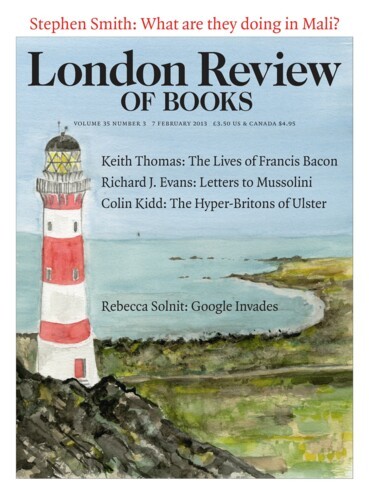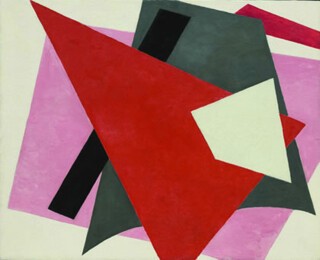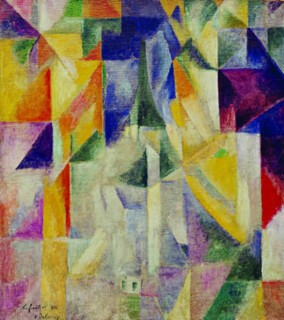When Alfred H. Barr Jr launched the Museum of Modern Art in New York in 1929, it was a paradoxical enterprise: a museum for an avant-garde art that was very much a work in progress. Nevertheless, for his landmark show Cubism and Abstract Art in 1936, Barr drew up a flow chart that funnelled the various streams of modernist practice to date into two great rivers that he named ‘geometrical abstract art’ and ‘non-geometrical abstract art’. In effect the diagram was a confident projection of a history that the museum would move, strategically, to display and to define. If modernist art was first made in Europe, it was first narrated in the US, and abstraction was its Geist.
Flash forward 77 years. For Inventing Abstraction, 1910-25 (until 15 April), the curator Leah Dickerman offers a different diagram: not a diachronic chart of tributary movements but a synchronic network of charismatic ‘connectors’, such as Vasily Kandinsky, F.T. Marinetti, Guillaume Apollinaire, Francis Picabia, Tristan Tzara, Theo van Doesburg and Alfred Stieglitz, all of whom were polemicists (critics, editors, exhibition-makers) as much as they were artists. Like the diagram, the exhibition looks back to the period when abstraction emerged, not forward to its eventual triumph; rather than project a telos to come, it historicises a moment a century ago. In doing so, the show suggests, perhaps involuntarily, a closure to this practice. Is abstraction ‘a thing of the past’, a form of art that, however world-historical once, is well behind us now?
Inventing Abstraction opens with a complicated Cubist figure by Picasso. It is a conventional enough beginning (recall the title of the Barr show), yet there is no way around it, nor should there be: even if Picasso never went abstract (neither did Matisse, for that matter), Cubism was the fountainhead of abstraction, and key protagonists like Piet Mondrian and Kazimir Malevich felt they had to work through it. Dickerman features Kandinsky next, but she does not present abstraction as having a simple origin. Its sources are transhistorical and multicultural (modernist inspirations include African art, Byzantine icons, and Islamic ornament): abstraction is always discovered as much as it is invented. That said, the purview of the show is strictly European (including Russia and Britain), though the selection is broad and various within this frame, with many provocative juxtapositions and far more women than in past shows (Sonia Terk and Sophie Taeuber, for example, get equal billing with their husbands, Robert Delaunay and Hans Arp). At long last such movements as Italian Futurism and Polish Constructivism are given their due, and lesser figures like the Britons Lawrence Atkinson and Duncan Grant, and the Americans Stanton Macdonald-Wright and Morgan Russell, have their day too. Given the cost of insurance, conservation concerns and political problems (Russia has an embargo on loans), we are not likely to see such an extraordinary gathering of abstract art from this period ever again.
Although Inventing Abstraction includes sculpture, photography and film, it runs heavy on painting. It wasn’t obvious how absolute abstraction was to be achieved in those other media, and the modernist project of ‘purity’ – of an art freed from both resemblance to the world and function within it – privileged painting in any case. At the same time, many painters needed the aid or at least the analogy of the other arts, music and poetry above all. Music had long been seen as the most abstract (‘all art constantly aspires to the condition of music,’ Walter Pater had said), and Dickerman points out the importance not only of Wagner’s chromaticism and Schoenberg’s atonality for Kandinsky (a Schoenberg concert in Munich on 2 January 1911 was an epiphany for the artist) but also of the structural reflexivity of Bach for Paul Klee (who was a gifted musician). As for poetry, Mallarmé had already announced a crisis, and the next generation took the attack on conventional sense to an extreme in Futurist parole in libertà (‘words in freedom’), Russian zaum (transrational) texts, and sound poems (Kandinsky, Arp, van Doesburg and Kurt Schwitters all produced important examples).
The tension between medium-specific and cross-media impulses was generative for early abstraction. Against formalist critics, from Roger Fry through to Clement Greenberg, who stressed the decorous ideal of painting as strictly visual and spatial, Inventing Abstraction shows how abstract artists were concerned often with the tactility of materials (faktura or ‘texture’ was a watchword of the Russians) and sometimes with the temporality of animation (alongside abstract films by Hans Richter, Viking Eggeling and László Moholy-Nagy, there are unexpected projects by Grant and by Léopold Survage, an artist of Finnish descent active in Paris). ‘Tested by abstraction, the boundaries of painting and other media began to dissolve,’ Dickerman argues in a riposte to the medium-specific position. For one thing, abstract painting prompted a loosening of the ground under the viewer: Malevich suggested aerial perspectives in some of his early abstractions, and El Lissitzky rotated his diagrammatic Prouns as he painted them in order to confound any sense of orientation. Such experiments led some painters – Kandinsky, Lissitzky, van Doesburg – to abstract interiors, both actual and projected, and there were other crossings as well. Dickerman opposes medium-specificity and cross-media exchange, but the two principles are not in complete contradiction: however opposed in method, the Gesamtkunstwerk and the pure painting are both committed to the idea of aesthetic autonomy.
Artists were on the verge of abstraction well before the breakthrough year of 1912: why was it such a difficult concept to accept, even for champions like Kandinsky? The principal reason was that it seemed to expose art to the arbitrary, the decorative, the subjective. If art was no longer rooted in the world, what might ground it? If it was no longer governed by the referent, what might motivate it? By and large artists sought a basis for abstraction at the two extremes, in the transcendental realm of the Idea (usually Platonic, Hegelian or theosophist) or in the material register of the medium; in this respect abstraction provided an aesthetic resolution to the philosophical contradiction between idealism and materialism, either of which it could serve. Against the arbitrary, artists like Kandinsky also asserted the ‘necessity’ of abstraction – history demanded it, art required it – and such assertions in turn prompted a flood of words: individual proclamations, group manifestos, lectures, treatises, journals. Dickerman views this visual-verbal relation as a symptomatic ‘split’, even a dissociation of sensibility: ‘This structure – of images and words existing in parallel spheres, the two held at a distance – suggests a division in modernism.’ Yet one might also see it as a relation of supplementarity, and deconstruct it accordingly: which term in the binary truly determines the other in each instance? However parsed, the insight that practice and theory (or, for that matter, performance and publicity) would thereafter compensate for one another in 20th-century art is an important one.
Abstraction had recourse not only to artistic analogies and textual reinforcements but also to radical developments in the sciences of the time, such as the theory of relativity, quantum physics and non-Euclidean geometry; yet more germane, Dickerman argues, were new philosophical paradigms like phenomenology and semiotics. According to phenomenology, perception is not detached and objective – not ‘realist’ in this sense – but subjective and embodied and thus to an extent ‘abstract’. So, too, semiotics discarded the belief that language referred directly to the world (here the intimacy of the linguist Roman Jakobson with Malevich is very telling). Although Dickerman alludes to the impact of new technologies and culture on abstraction, one would like to hear more on this score. The exhibition offers a strong sense of the ambiguous attractions of the abstract world of the industrial machine, as differently evoked by the Futurists, Fernand Léger and Marcel Duchamp, but little sense of the abstractive force of the mass-produced commodity, the becoming-abstract of capitalist life, as variously explored by Georg Simmel, György Lukács and Alfred Sohn-Rethel. After Greenberg (not to mention Theodor Adorno), we often think of abstraction as a withdrawal from the modern world, almost a safehouse for art, but the converse is just as true: the modern world became too abstract to represent in the old ways.
Dickerman revises Barr dramatically, but not when it comes to the affirmation of abstraction, in which MoMA is still very invested. ‘The propositions were many, and at times contradicted each other,’ she concludes, ‘but in their aggregate they marked the demise of painting in its traditional form and its opening to the practices of the century to come.’ But was abstract painting as absolute a rupture as this makes out? Dickerman insists on its fundamental break with the old model of the perspectival picture, with its metaphor of a window onto a world, its sublimation of the materiality of the painting, its assertion of ‘the primacy of the visual’, its assumption of ‘a discarnate gaze’ and so on. This is true enough: for some artists, such as Aleksandr Rodchenko, abstraction did put paid to the project of representation. Yet for others it was the purification of painting, not its end but its epitome (this is an essential meaning of ‘pure painting’). Given the Hegelian cast of some theorists, abstraction might be understood in large part as the sublation of representation, that is, as its simultaneous negation and preservation. Thus, even as abstractionists like Kandinsky, Malevich and Mondrian cancelled any resemblance to reality, they also affirmed an ontology of the real; even as they rejected painting as a picture of the epiphenomenal world, they insisted on painting as an analogue of a noumenal world: appearance was sacrificed at the altar of transcendence. So, too, even as these artists broke with representational painting, they often did so in a way that continued the tradition of the tableau, reaffirming its criteria of compositional unity for the artwork and epiphanic experience for the viewer. In this respect the glorious Windows of Delaunay reflects on picturing in a way that rivals any self-aware painting by Velázquez or Vermeer.
So if ‘the demise of painting in its traditional form’ was not total, what about the ‘opening to the practices of the century to come’? Inventing Abstraction contains examples of avant-garde inventions nearly coeval with abstract painting, such as non-objective collage, relief and construction (an impressive model of the unbuilt Monument to the Third International by Vladimir Tatlin dominates one gallery). For Dickerman, abstraction prepares these devices and others too, including all that we comprehend by the name ‘Duchamp’: the readymade, experiments with chance, the artwork as idea and so on. Yet this strong claim is open to argument: already in the chart drawn up by Barr for MoMA, and later in the theory of ‘modernist painting’ promulgated by Greenberg, abstraction comes to displace these other strategies, and it would not be until after the dominance of abstract expressionism, in the neo-avant-gardes of the 1950s and 1960s, that they returned with any force. Abstraction was a break, to be sure, but it was also used to defend against other breaks that were perhaps more radical.
The final gallery of the show suggests the mixed fortunes of abstraction: there is a testament to abstraction as the necessary future not only of modernist art but of modern life tout court in the form of experimental pieces by Moholy-Nagy, a near travesty of abstraction as a kind of Dadaist nonsense in ornamental objects by Taeuber and Arp, and a set of essays in abstract form by Katarzyna Kobro and Władysław Strzemiński which, however exquisite, also appear stunted, with nowhere to go historically. And what about abstraction today? It does not pretend to the great ambitions – revolutionary, utopian, transcendental – of this early period; that is obviously not our mode. Many artists treat abstraction as a distant archive to cite more than as a continuous tradition to develop – but then nothing can be world-historical twice.
Send Letters To:
The Editor
London Review of Books,
28 Little Russell Street
London, WC1A 2HN
letters@lrb.co.uk
Please include name, address, and a telephone number.



